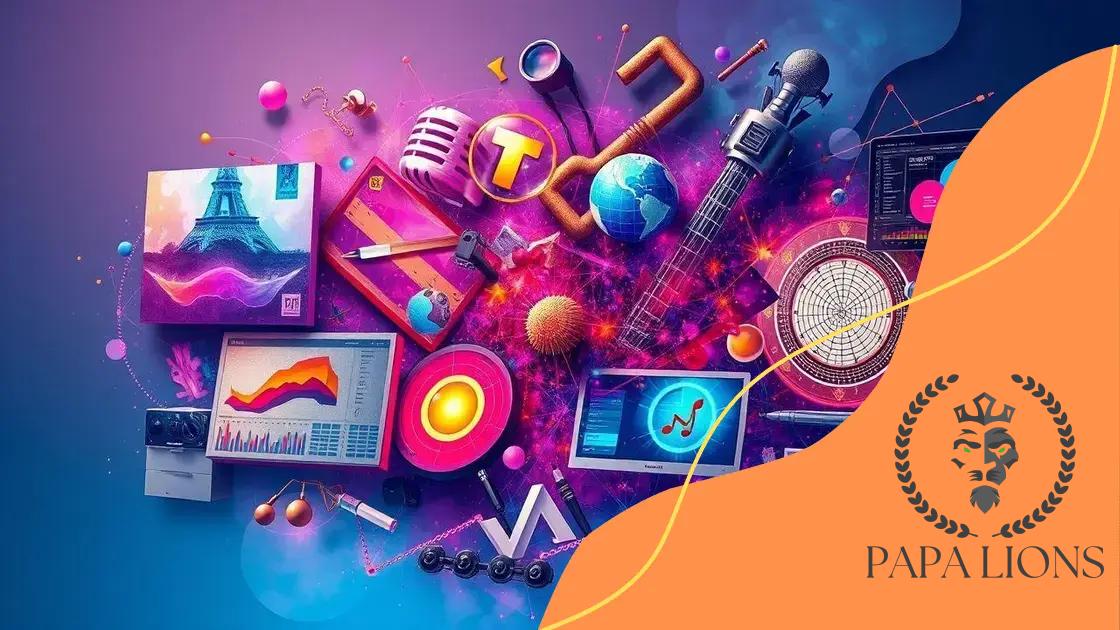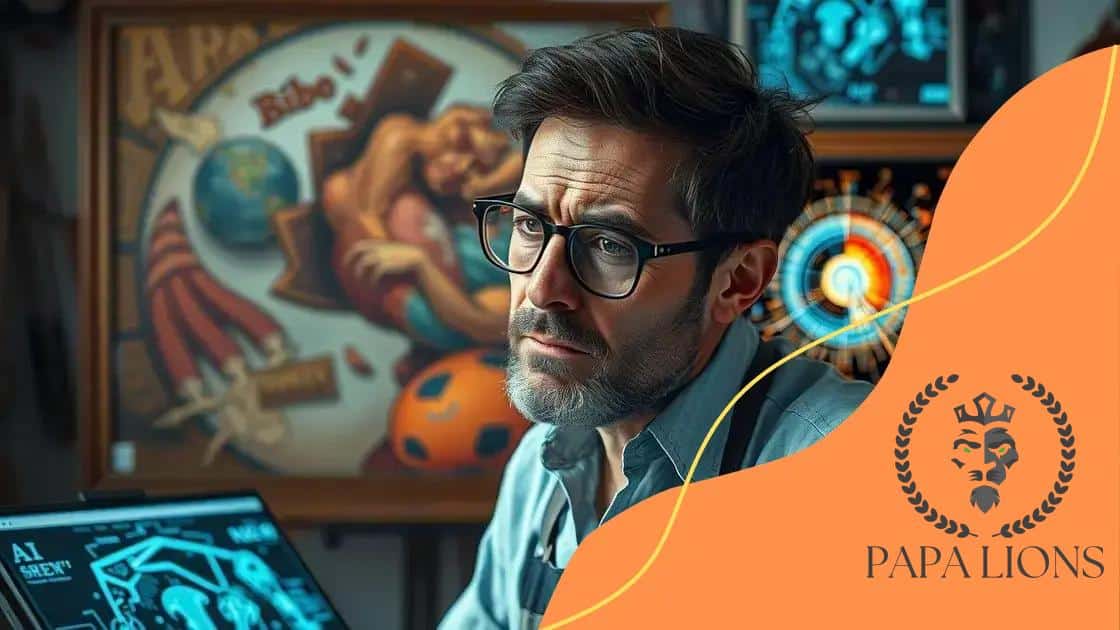The role of AI in transforming the creative industries

The role of AI in transforming the creative industries involves enhancing artistic expression, creating innovative tools for artists, and fostering collaboration, while also raising ethical concerns about authorship and the impact on traditional creative roles.
The role of AI in transforming the creative industries is becoming increasingly evident. As technology evolves, many of us wonder how this shift affects the way we create and enjoy various forms of art. Let’s dive into this intriguing transformation!
Understanding AI’s impact on creativity
Understanding the impact of AI on creativity is essential in today’s rapidly changing landscape. With the rise of technology, the ways in which we create art, music, and other forms of expression are evolving significantly.
AI’s Influence on Artistic Creation has opened up new avenues for artists. Now, creators can use algorithms to generate visuals and sounds that were previously unimaginable. These innovations enhance the creative process, making it more dynamic and exciting.
Key Benefits of AI in Creativity
- Enhanced Inspiration: AI tools can provide unique ideas and perspectives.
- Efficiency: Automating repetitive tasks allows artists to focus more on their creative vision.
- Collaboration: AI systems can partner with humans, creating hybrid forms of art.
Moreover, as we explore AI’s role, we see how it challenges traditional notions of authorship and originality. Consider how a machine can compose music or generate paintings. This idea might seem strange, but it opens discussions about what it means to be creative.
Artists are now blending their skills with AI technologies, resulting in innovative works that reflect this collaboration. Examples range from AI-generated films to interactive installations that change based on viewer engagement. Such projects showcase the limitless potential when artists embrace AI.
Challenges and Concerns
Despite these benefits, there are challenges. Some worry about the loss of traditional skills as AI becomes more integrated into creative fields. Questions of authenticity persist, alongside concerns about job displacement within the industry. However, many believe that these tools can complement human creativity rather than replace it.
The conversation around AI in the arts is ongoing, with many artists advocating for the technology’s potential to enhance rather than dilute human expression.
As we navigate this landscape, it’s crucial to maintain a balance. Embracing AI can lead to new forms of creativity, helping us redefine what it means to be an artist in the modern world.
How AI enhances artistic expression
How AI enhances artistic expression is a fascinating topic that reveals new techniques and opportunities for creators. With advancements in technology, artists can now explore innovative ways to express their visions.
AI Technology in Art provides tools that help artists push the boundaries of creativity. By utilizing machine learning algorithms, creators can generate unique patterns, designs, and sounds that might not occur through traditional methods.
Benefits of AI for Artists
- Expanded Creativity: AI can suggest ideas and variations that inspire artists.
- Personalization: Tools can be tailored to match individual styles, enhancing the artist’s unique voice.
- Collaboration: AI can act as an artistic partner, making the creative process more interactive.
The collaboration between humans and AI leads to surprising results. For example, composers use AI to generate musical sequences that complement their compositions. This partnership can lead to entirely new genres and sounds that engage audiences in fresh ways.
Similarly, visual artists may employ AI to create stunning digital paintings, where the machine learns from existing art styles and applies them in innovative combinations. Artists can manipulate these outputs to refine their own techniques and develop something truly unique.
Challenges with AI in Art
While the benefits are numerous, artists face challenges when integrating AI into their work. Concerns about authenticity can arise, as some question whether AI-generated pieces can be considered true art. Additionally, there is ongoing debate on the ethical implications of using AI in creative fields.
Nonetheless, by exploring and addressing these challenges, artists can fully harness the potential of AI. By embracing new technologies, they can enhance their artistic expression and connect with audiences like never before.
Challenges of integrating AI in creative fields

Challenges of integrating AI in creative fields are becoming more prevalent as artists and creators begin to work alongside technology. As exciting as the possibilities are, there are significant hurdles to overcome.
One major challenge is the question of authenticity. When machines generate art or music, it raises the issue of what it truly means to be an artist. How do we define the line between human creativity and machine output? This question frequently surfaces in discussions about the role of AI in creative processes.
Ethical Considerations
- Copyright Issues: Determining who owns AI-generated works can be complicated.
- Job Displacement: There are fears that AI could replace human jobs in creative sectors.
- Bias in AI: If not carefully managed, AI can reflect biases in its outputs.
Ethical considerations also play a crucial role in the integration of AI into creative fields. For instance, copyright issues arise when considering ownership of AI-generated content. If a machine creates a painting or a song, who is the true creator: the programmer, the user, or the machine itself? Establishing clear guidelines is essential for resolving these dilemmas.
Additionally, there are concerns about job displacement. Many creators worry that as AI tools become more prevalent, they may be replaced by machines. While technology often creates new opportunities, it can also disrupt traditional fields. Artists need to adapt and find new ways to incorporate AI into their work without losing their unique voice.
Balancing Innovation and Tradition
Moreover, maintaining a balance between innovation and tradition is a tough task for artists. As they navigate the complexities of AI tools, they must ensure they retain their artistic integrity. Artists are finding ways to blend AI innovations with their traditional methods, creating exciting hybrid forms of expression.
Ultimately, while there are challenges to integrating AI in creative fields, many artists are rising to meet them. By addressing ethical concerns and redefining collaboration, they are shaping a landscape where both technology and creativity coexist harmoniously.
Case studies of AI in art and music
Case studies of AI in art and music reveal powerful examples of how technology transforms creative expression. These examples showcase both innovative applications and the impact of AI on established practices.
In the world of visual art, one notable case is the work of the AI program named DeepArt. This software takes images and reimagines them in the style of famous artists like Van Gogh or Picasso. Artists and designers use DeepArt to generate unique artwork that blends style and content in fascinating ways. It provides a new medium for artistic exploration, allowing for creativity that combines human input with machine learning.
AI in Music Creation
- AIVA: An AI composer that creates original music.
- OpenAI’s Jukedeck: Generates custom music tracks for videos.
- Amper Music: Helps creators produce music quickly for various projects.
When it comes to music, AIVA is a prime example. It composes classical music by learning from a vast database of compositions. Not only does it create original pieces, but it can also adapt its style based on user preferences. Musicians and producers find AIVA’s capabilities useful for inspiration or as a starting point in their creative process.
Another case worth noting is OpenAI’s Jukedeck, which allows users to craft custom music tracks effortlessly. This platform demonstrates how AI can democratize music production, making it accessible to those who may not have extensive training in music theory or composition. Such tools are changing the landscape, allowing more creators to add professional soundtracks to their projects.
Visual Art Installations
Beyond digital art and music, AI has begun to play a role in physical art installations. For instance, artist Refik Anadol creates immersive experiences using AI to animate public spaces with dynamic visuals based on data. This fusion of technology and art invites audiences to engage with art in new and exciting ways.
As these case studies illustrate, the integration of AI in art and music unlocks new creative possibilities while also raising important questions about authorship and originality. Artists are not just consumers of technology; they are active participants in a dialogue that shapes the future of creativity.
The future of creativity with AI
The future of creativity with AI is an exciting realm filled with possibilities. As technology evolves, the creative process continues to change, blending human ideas with machine capabilities.
Innovative tools powered by AI are emerging rapidly, helping artists, musicians, and other creators explore new dimensions of their work. For example, AI-based applications can analyze existing art styles and suggest unique combinations or variations, encouraging artists to experiment with their craft.
Emerging Trends in AI and Creativity
- Personalized Art Creation: AI can learn an artist’s style and create customized art pieces.
- Interactive Experiences: AI can power installations that respond to audience interactions.
- Collaborative Creation: Artists can work alongside AI programs as creative partners.
One emerging trend is the use of AI to generate personalized art. Imagine an artist using software that understands their style and produces artwork based on their preferences. This level of customization allows for deeper artistic expression and encourages fresh ideas.
Additionally, the integration of AI in interactive art installations is gaining popularity. For instance, exhibits that respond to viewer movements or emotions challenge traditional boundaries between the artist and the audience. These experiences not only engage viewers but also redefine how we experience art.
Addressing Challenges and Ethical Concerns
While the future looks promising, there are challenges that must be faced. Ethical concerns regarding authorship and the use of data to train AI systems are important topics. As creators adopt these technologies, they should remain mindful of how they affect artistic integrity.
Despite these challenges, AI is expected to complement human creativity rather than replace it. The collaboration between humans and machines can lead to remarkable innovations, providing artists with new tools to express their visions and connect with audiences in unique ways.
As we move forward, the relationship between AI and creativity will continue to evolve. Together, they will shape the future of artistic expression, turning ideas into engaging experiences that inspire and challenge us.
FAQ – Frequently Asked Questions about the role of AI in transforming the creative industries
How is AI changing the way artists create?
AI provides tools that allow artists to explore new styles and methods, enhancing their creative process.
What are the ethical concerns related to AI in art?
Concerns include authorship, copyright issues, and the potential displacement of traditional artists.
Can AI help in music production?
Yes, AI tools can generate original music and assist producers in creating custom soundtracks for various projects.
What is the future potential of AI and creativity?
The future holds exciting opportunities for collaboration between AI and artists, leading to innovative forms of expression.





